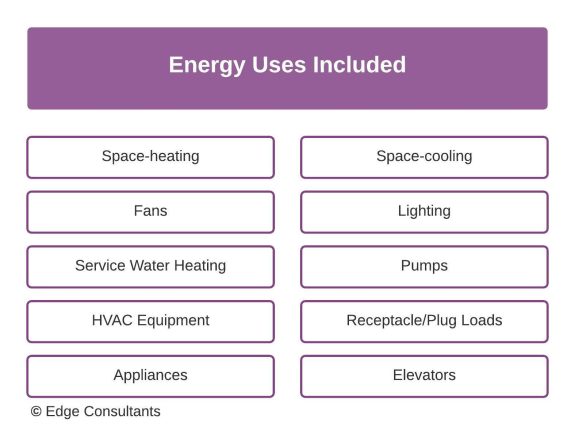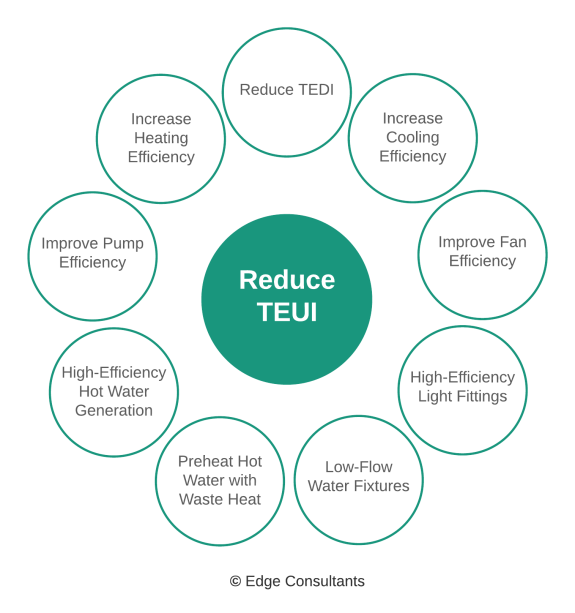TEUI is a measure of the total energy required to operate a building. It is a metric that is used to reduce the operational energy required by new buildings.
What does TEUI mean?
TEUI stands for Total Energy Use Intensity.
Many readers are likely familiar with the term ‘EUI’. EUI stands for energy use intensity and is a common metric that has been used in many countries around the world for benchmarking the energy performance of buildings. TEUI is used in the City of Vancouver’s energy compliance limits and in the BC Energy Step Code. TEUI is the same metric as EUI with another letter added to the name. When speaking about TEUI, it is commonly pronounced the same as how you would say “2E”.
It is a measure of the total energy required by a building. It includes all energy uses that are required to operate a building; these include space heating, lighting, air conditioning, heating hot water, and many other end uses. It is quantified on an annual basis, so when thinking about TEUI, one should imagine a building over the course of one full year.
TEUI is quantified on a floor area basis. It is the amount of energy (in kWh) divided by the floor area of the building (in meters squared); the unit for TEUI is kWh/m2. As mentioned previously, it is on an annual basis. If a 10,000m2 building requires 1,000,000 kWh of energy and a 1,000m2 building consumes 100,000 kWh, both buildings have a TEUI value of 100 kWh/m2 per year.
TEUI was introduced to create performance limits for new buildings. The purpose of the metric is to reduce the operational energy of a building. Reducing operational energy reduces the greenhouse gas emissions associated with the building. So, TEUI is a way to reduce emissions in new buildings.
What energy uses are included in TEUI?
Any energy that is used for the normal operation of a building should be included when calculating the TEUI of a building. The following graphic shows the energy uses to be combined to find total energy use for the purpose of calculating TEUI. The energy uses shown are based on the definition of TEUI provided in the BC Building Code

How can the TEUI value be improved?
Improving the TEUI value of a building means reducing that value. Any decrease in the operational energy used in a building will reduce the TEUI value. There is a plethora of ways to decrease a building’s energy use; the following graphic gives an example of some options.

How are TEDI and TEUI related?
TEDI and TEUI are both energy performance limits used in the City of Vancouver’s energy compliance requirements and in the BC Energy Step Code.
TEDI stands for Thermal Energy Demand Intensity. The following article should quickly bring any reader that is not familiar with TEDI up to speed: https://edgesustainability.com/improvements-to-tedi-and-the-associated-impacts/
TEDI is a measure of the thermal energy (energy in the form of heat) required by a building for space conditioning and for conditioning of ventilation air. TEDI is energy used by the building during normal operation. Therefore, the energy that defines TEDI is included in the energy that defines TEUI. TEDI is a subset of TEUI. If TEDI is reduced, TEUI is reduced.
An important point to highlight when speaking about the relationship between TEDI and TEUI is regarding heating efficiency. The efficiency of heat generation has no impact on TEDI. It has a direct impact on TEUI.
As mentioned in the above linked article, how the heat required by a building is generated does not have any influence on the TEDI value. The TEDI value only considers the heat load. It does not matter how this heat load is generated. The heat load is all that matters. This is not the case for TEUI.
The same example used in the article relating to TEDI is suitable for explaining how heating efficiency relates to TEUI. An office building has a rooftop air handling unit that heats incoming outside air with a hot water coil prior to supplying air into the building. Whether that water was heated using a gas boiler with an efficiency of 80% or an air-source heat pump with a COP of 3 (300% efficient) made no difference to the TEDI value, but it has a direct impact on the TEUI value for the building. The same amount of heat is required in both instances, but the energy used to generate this heat is significantly different.
Is reducing the TEUI value a positive thing?
Put simply, yes. Reducing the energy used to operate a building directly reduces the greenhouse gas emissions associated with operating that building. This can only be seen as a positive in the efforts to combat global warming. TEUI is a metric used to drive down the greenhouse gas emissions of new buildings. It is a suitable metric that is successful in achieving the desired goal.
3 comments on “TEUI Explained and Tips to Improve”
Comments are closed.